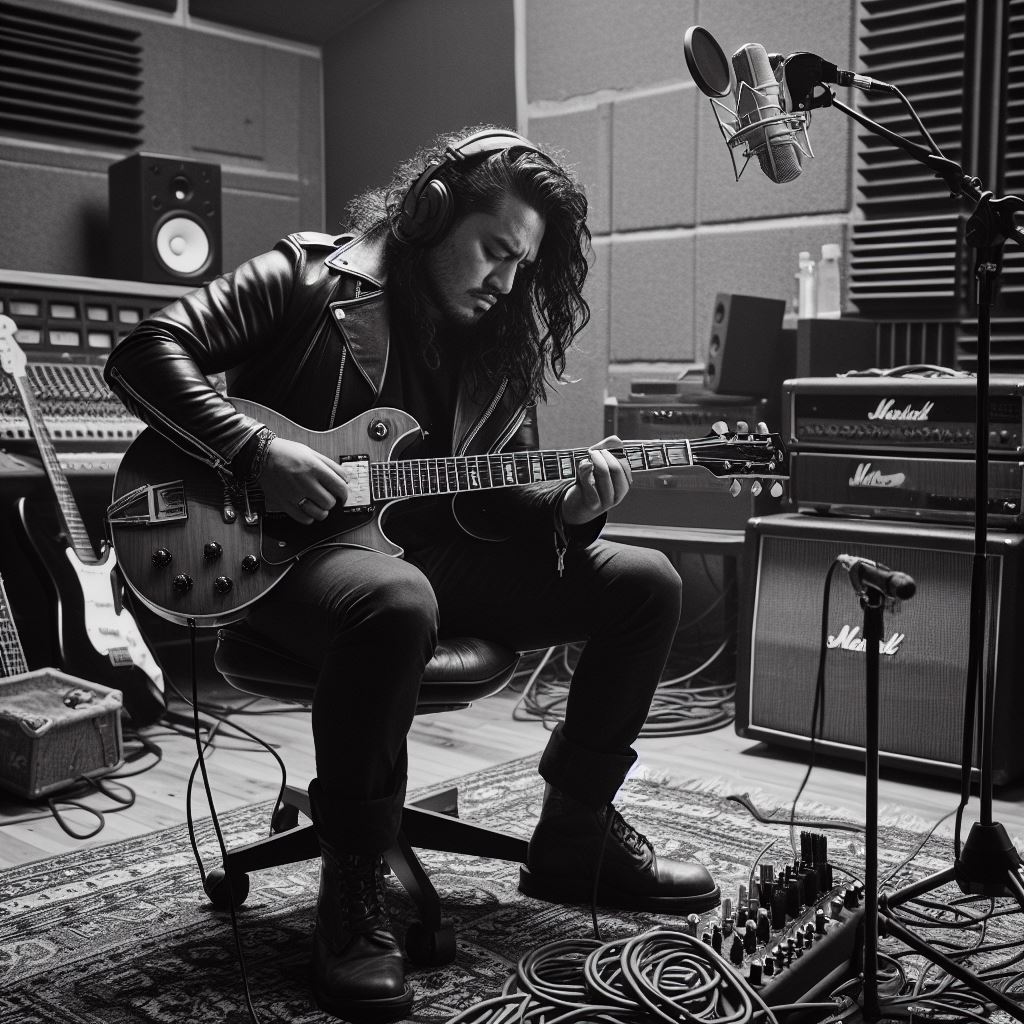Introduction
DIY recording empowers Kiwi artists to take control of their music production process and save on expenses.
This blog post aims to equip them with valuable tips and strategies for successful DIY recording endeavors.
By embracing DIY recording, Kiwi artists can unleash their creativity without relying on professional assistance or expensive studio equipment.
This approach allows them to experiment freely and express their artistic vision without constraints.
The tips provided in this blog post cover various aspects of DIY recording, including equipment selection, room acoustics, recording techniques, and post-production processes.
Kiwi artists can learn how to set up a home recording studio, choose the right microphones and audio interfaces, and optimize their recording environment for the best results.
Furthermore, the blog encourages Kiwi artists to explore online resources, attend workshops, and listen to recordings by successful DIY artists for additional learning and inspiration.
By continuously honing their skills and experimenting with new techniques, Kiwi artists can elevate their DIY recording projects to new heights and produce professional-quality music from the comfort of their own homes.
Setting up Your Recording Space
A. Choosing an appropriate location
- Find a quiet area in your home, away from noise and distractions.
- Ensure the space has enough room for your equipment and allows for easy movement.
- Consider natural light and ventilation to create a comfortable atmosphere for recording.
B. Dealing with soundproofing and acoustics
- Use heavy curtains, carpets, and acoustic panels to reduce echo and external noise.
- Seal any gaps or cracks in walls, windows, or doors to prevent sound leakage.
- Consider investing in a portable vocal booth or isolation shields for better sound isolation.
C. Selecting the right equipment and software
- Choose a reliable audio interface that suits your needs and budget.
- Invest in a good quality microphone that captures your voice or instrument accurately.
- Research and compare recording software options to find one that is user-friendly and meets your requirements.
A. Equipment Checklist
- Audio interface
- Microphone(s)
- Headphones
- Pop filter or windscreen
- Mic stands or boom arms
- Cables (XLR or USB)
- Studio monitors or quality speakers
- MIDI keyboard or other instruments (if needed)
- Reflection filters or diffusers (if necessary)
B. Software Checklist
- Digital Audio Workstation (DAW) software, such as Pro Tools, Logic Pro, or Ableton Live
- Virtual instruments and plugins for adding effects and processing sounds
- Mixing and mastering tools for finalizing your recordings
C. Additional Tips
- Experiment with microphone placement to find the best sound for your vocals or instruments.
- Use headphones while recording to monitor your sound and avoid feedback.
- Test different combinations of audio settings and effects to enhance your recordings.
- Take breaks and listen to your recordings in different environments to ensure quality.
- Regularly update your software and check for firmware updates for your equipment.
By setting up your recording space properly, you can create a comfortable environment conducive to high-quality recordings.
Read: NZ Bands Making Global Waves
Preparing for a Recording Session
A. Setting clear goals and objectives
- Determine the primary purpose of the recording session, whether it’s for a demo or a full album.
- Define the desired outcome, such as creating a polished and professional-sounding recording.
- Identify specific goals, such as capturing the energy and emotion of the performance.
- Set realistic and achievable objectives, such as recording one or two songs per session.
B. Planning the recording process and timeline
- Create a detailed plan outlining the steps involved in the recording process.
- Determine the number of songs to be recorded in each session, considering time constraints.
- Allocate ample time for rehearsals, soundchecks, and any necessary adjustments before recording.
- Consider scheduling breaks to prevent fatigue and maintain focus during the recording sessions.
- Establish a realistic timeline that allows for flexibility and potential challenges that may arise.
C. Professionalism and maintaining a positive mindset
- Treat the recording session as a professional endeavor, regardless of its scale.
- Arrive on time, prepared, and ready to give your best performance.
- Communicate clearly and respectfully with the recording engineer and other team members.
- Stay focused and maintain a positive attitude, even during challenging moments.
- Embrace constructive feedback and be open to making adjustments for the benefit of the recording.
- Take care of yourself physically and mentally to ensure optimal performance throughout the session.
Preparing for a recording session involves setting clear goals and objectives, planning the process and timeline, as well as maintaining professionalism and a positive mindset.
By following these tips, Kiwi artists can ensure a successful and rewarding recording experience.
Read: Maori Music: NZ’s Rich Heritage
Recording Techniques and Tips
A. Mic placement and selection for different instruments
- Place the microphone close to the sound source to capture a focused sound.
- Experiment with different mic positions to find the sweet spot for each instrument.
- Choose the right microphone that complements the instrument’s tonal characteristics.
- Consider using dynamic microphones for loud instruments and condenser microphones for more delicate sounds.
B. Setting up proper headphone mixes
- Ensure that each musician can clearly hear themselves and the other instruments in the mix.
- Use individual headphone amplifiers for each musician to prevent volume discrepancies.
- Communicate effectively with the musicians to understand their preferences for the mix.
- Regularly check the headphone levels during the recording to avoid distortion or ear fatigue.
C. Optimizing levels and avoiding clipping
- Monitor the input levels and adjust the gain to prevent the signal from peaking into the red zone.
- Leave some headroom by setting the levels slightly lower to avoid clipping and distortion.
- Consider using a limiter or a compressor to automatically control sudden volume spikes.
- Regularly check for clipping during the recording process and make necessary adjustments.
D. Using EQ, compression, and other effects effectively
- Learn how to use EQ to enhance the tonal balance of each instrument and create separation.
- Experiment with different compression settings to control dynamics and add sustain if necessary.
- Use subtle reverb to add depth and create a sense of space in the mix.
- Be cautious when applying effects and avoid over-processing, as it can result in a muddy mix.
By implementing these recording techniques and tips, Kiwi artists can elevate the quality of their DIY recordings and showcase their talent in the best possible way.
Read: NZ Music Festivals: Behind Scenes

Troubleshooting Common Recording Issues
When it comes to DIY recording, it’s common to encounter various issues that can affect the quality of your recordings.
However, with the right troubleshooting techniques, you can overcome these challenges and achieve professional-sounding results.
This section will discuss some of the most common recording issues and how to address them effectively.
A. Dealing with background noise and unwanted sounds
Background noise and unwanted sounds can significantly degrade the quality of your recordings.
To tackle this issue:
- Identify the source of the background noise and try to eliminate it before recording. For example, turn off appliances or move away from noisy areas.
- Use soundproofing materials like foam or acoustic panels to minimize outside noise. These can be placed on walls or around the recording area.
- Close windows and doors to block out external sounds that may creep into your recordings.
- Consider using a noise gate plugin during post-production. This tool helps reduce the volume of audio below a certain threshold, effectively eliminating unwanted sounds.
- Choose a quiet location for recording. This could be a room with minimal background noise, away from traffic or other sources of disturbance.
B. Addressing microphone bleed and interference
Microphone bleed and interference can occur when you capture unintended sounds from other instruments or vocals.
To minimize this issue:
- Position microphones carefully to reduce bleed from other sources. Experiment with different microphone placements.
- Use headphones to monitor your recordings. This allows you to catch any interference or bleed issues and make adjustments accordingly.
- Experiment with microphone polar patterns. Some microphones offer different patterns that you can select to reduce unwanted sound pickup.
- Ensure all cables are properly shielded. Cables without shielding are more susceptible to electromagnetic interference from other electronic devices.
- Consider using a noise suppression plugin during post-production. This can help minimize microphone bleed and interference.
C. Troubleshooting technical difficulties
Technical difficulties can arise during recording sessions, but there are steps you can take to address them:
Personalized Career Consulting
Unlock your potential with expert career advice tailored to your goals. Get personalized guidance and actionable steps toward your dream career in New Zealand.
Get Started- Check all cables and connections to make sure they are secure and properly connected. Loose connections can cause signal interruptions or noise problems.
- Update and maintain your recording software and hardware regularly to avoid compatibility issues or bugs that can disrupt your recording workflow.
- If you encounter software or hardware glitches, try restarting your computer or audio interface. This simple solution often resolves many technical problems.
- Monitor your recording levels closely to prevent clipping or distortion. Adjust the gain settings on your interface or preamp if necessary.
- Keep your recording equipment clean and free from dust or debris. Regular maintenance can help prevent technical issues caused by dirty connections or equipment.
By understanding and effectively troubleshooting these common recording issues, you can ensure a smoother and more professional recording experience.
With consistent practice and problem-solving skills, you’ll be on your way to creating high-quality recordings as a DIY artist.
Read: Women in NZ Music: Rising Stars
Editing and Mixing Your Recordings
A. Organizing and labeling your tracks
- Start by giving each track a clear and descriptive name to make navigating your project easier.
- Organize your tracks in a logical manner, grouping similar instruments or vocal takes together.
- Use color-coding to visually distinguish between different types of tracks, making it easier to find what you need.
- Label sections of your project timeline to mark important parts, such as verses, choruses, and bridges.
B. Trimming, cutting, and arranging recordings
- Listen to your recordings carefully and identify any unwanted noises or mistakes.
- Trim the beginning and end of each track to remove any unnecessary silence or unwanted sounds.
- Cut and arrange your recordings in a way that flows naturally and captures the essence of your song.
- Experiment with different arrangements to see what works best for your musical vision.
C. Applying basic mixing techniques
- Start by setting the levels of each track so that they are balanced and can be heard clearly.
- Use EQ (equalization) to enhance or reduce certain frequencies in each track, making them fit together better.
- Apply compression to control the dynamic range and make your recordings sound more polished.
- Use reverb and delay effects to add depth and create a sense of space in your mix.
D. Balancing levels and panning
- Adjust the levels of each track so that they sit well together in the mix, making sure none are too loud or too soft.
- Use panning to position sounds in the stereo field, creating a three-dimensional soundstage.
- Experiment with panning different tracks to create a sense of movement and separation in your mix.
- Regularly listen to your mix in mono to ensure it translates well across different playback systems.
E. Using plugins and effects to enhance the sound
- Explore different plugins and effects to add creativity and uniqueness to your recordings.
- Experiment with EQ, compression, saturation, and other effects to shape the tone of your tracks.
- Use automation to create dynamic changes in volume, panning, or effect parameters over time.
- Be mindful not to overuse plugins and effects, as they can easily clutter your mix and mask the original sound.
Remember, the key to successful editing and mixing is to trust your ears and use your creativity.
Don’t be afraid to experiment and try new techniques to achieve the perfect sound for your recordings.
With practice and patience, you can elevate your DIY recordings to a professional level. Happy mixing!
Mastering and Finalizing Your Track
A. Understanding the purpose of mastering
Mastering is the final step in the recording process where the track is optimized for distribution.
It ensures the overall balance, clarity, and consistency of the audio across different playback systems.
Professional mastering can bring out the best in your music and make it sound polished and professional.
B. Preparing your mix for mastering
- Double-check your mix: Before sending it for mastering, carefully listen to your mix and ensure that it is balanced and free from any technical issues like clipping or distortion.
- Leave headroom: Make sure that your mix has enough headroom to allow the mastering engineer to apply processing without causing any further distortion. Leaving at least -3dB of headroom is generally recommended.
- Remove unnecessary processing: Strip away any additional processing like EQ, compression, or effects from the master channel. These decisions should be left to the mastering phase.
C. Using EQ, compression, and limiting during mastering
- EQ: Use EQ to shape the overall tonal balance of your track. Boost or cut specific frequencies to enhance certain elements or address any tonal imbalances. Be subtle and make small adjustments.
- Compression: Apply compression to control dynamics and add punch to your music. However, be cautious not to overdo it as excessive compression can squash the life out of your mix. Use a gentle and transparent approach.
- Limiting: Use a limiter to increase the overall loudness of your track and ensure it competes with other commercial releases. Be careful not to push it too hard, as excessive limiting can cause unwanted distortion and artifacts.
D. Exporting and formatting your final track
- Choose the right file format: For online distribution, the most common file format is WAV or AIFF, which offer uncompressed and high-quality audio.
However, for streaming services, consider using compressed formats like MP3 or AAC. - Set the appropriate sample rate and bit-depth: Stick to the same sample rate (e.g., 44.1kHz) and bit-depth (e.g., 24-bit) you used during recording and mixing.
Higher sample rates and bit-depths can result in larger file sizes but may not significantly improve the sound quality. - Add metadata: Include relevant metadata such as track title, artist name, album title, and genre.
This information will be embedded within the file and helps with proper organization and identification. - Dial in the right levels: Avoid clipping when exporting your final track. Aim for a peak level between -0.5dB and -1dB to prevent any distortion during playback.
In essence, mastering is a crucial step in achieving a professional sound for your music.
By understanding its purpose, adequately preparing your mix, and using EQ, compression, and limiting effectively,
you can enhance the overall quality of your tracks.
Ensure to export and format your final track correctly for distribution.
Promoting and Distributing Your Music
A. Importance of a strong online presence
- Establishing an online presence is crucial for promoting and distributing your music effectively.
- A strong online presence allows you to reach a wider audience and connect with potential fans.
- Create a professional website and regularly update it with your latest music, news, and upcoming events.
- Use search engine optimization techniques to ensure that your website ranks high in relevant online searches.
- Regularly post engaging content on social media platforms to drive traffic to your website.
B. Utilizing social media and music streaming platforms
- Social media platforms like Facebook, Instagram, Twitter, and YouTube are powerful tools for promoting your music.
- Create engaging posts, share behind-the-scenes content, and interact with your followers.
- Utilize music streaming platforms like Spotify, Apple Music, and SoundCloud to reach a wider audience.
- Release your music on these platforms and encourage your fans to listen, share, and add your songs to playlists.
- Collaborate with influencers and other artists to expand your reach and gain more exposure.
C. Engaging with fans and building a loyal audience
- Engage with your fans by responding to their comments, messages, and feedback promptly.
- Host Q&A sessions or live streams to interact directly with your audience and build a personal connection.
- Regularly update your fans with news, new music releases, and upcoming shows through email newsletters.
- Offer exclusive content or rewards to your most loyal fans to establish a sense of community and appreciation.
- Networking events and fan meet-ups are great opportunities to connect with your fans in person and build a strong fan base.
D. Exploring local gig opportunities and networking
- Engage with the local music scene by actively seeking gig opportunities in your area.
- Research and approach local venues, bars, and clubs to secure performance slots.
- Attend local music industry events, conferences, and workshops to network with industry professionals.
- Collaborate with other local artists and bands to share audiences and expand your reach.
- Leverage your local connections to gain exposure and increase your chances of getting booked for gigs.
In generally, promoting and distributing your music requires a combination of online and offline strategies.
Building a strong online presence, utilizing social media and music streaming platforms, engaging with fans, and exploring local gig opportunities are essential for success as a Kiwi artist.
Remember to stay proactive, be creative in your approach, and consistently work towards expanding your audience and reaching your musical goals.
Conclusion
Let’s recap the key DIY recording tips for Kiwi artists:
Transform Your Career with a Professional CV and Cover Letter
Stand out to employers with an ATS-optimized resume and tailored cover letter designed to match your dream role. Let us craft your job application materials for success!
Get Started- Invest in good quality equipment, such as microphones and audio interfaces.
- Create a suitable recording space by minimizing background noise and optimizing acoustics.
- Experiment with different microphone placements to find the best sound for each instrument or vocal.
- Learn to use recording software effectively, adjusting levels and applying necessary effects.
- Take advantage of online tutorials and resources to further enhance your recording skills.
- Collaborate with other artists to share knowledge and learn from each other’s experiences.
With these tips in mind, I encourage all Kiwi artists to start recording and experimenting.
For additional learning and inspiration, I suggest checking out websites and forums dedicated to DIY recording, attending workshops or courses, and listening to recordings by successful DIY artists.
Keep exploring and honing your craft!




